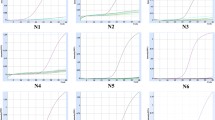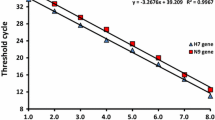Abstract
A real-time reverse-transcription PCR (RRT-PCR) was developed to detect and pathotype avian paramyxovirus type 1 (APMV-1), also known as Newcastle disease virus (NDV), which had been grown in embryonated fowls’ eggs. Two pairs of probes, VRP1 with ARP1 and VRP2 with ARP2, each with either the ‘universal base’ 2′ deoxyinosine incorporated or both inosines and locked nucleic acids (LNAs) incorporated, were designed to detect, respectively, a diverse range of virulent and avirulent viral templates that included the region coding for the fusion protein cleavage site. Oligonucleotide VRP1 hybridised with 76 of the 84 virulent isolates tested, while VRP2 detected 82, including 17 isolates with five or six template-probe mismatches. An alternative conventional probe, VRP3, with no inosine bases or LNAs, failed to hybridise 7 of 13 isolates, all of which tested positive with VRP2. Real-time assays with ARP1 showed that it detected 21 of the 28 avirulent isolates tested, and ARP2 detected 22/28, including one present in a mixture with virulent NDV. Neither probe was able to detect those isolates that were classified in genogroup six. All probes were specific for detecting either virulent or avirulent NDV. A specific PCR fragment of the predicted size was obtained, using the primer set designed for this study, with the 112 NDV isolates tested, including those in genogroup six. This assay demonstrates a rapid means for simultaneous detection and pathotyping of notifiable avian disease due to NDV.
Similar content being viewed by others
References
Aldous EW, Collins MS, McGoldrick A, Alexander DJ (2001) Rapid pathotyping of Newcastle disease virus (NDV) using fluorogenic probes in a PCR assay. Vet Microbiol 80:201–212
Aldous EW, Alexander DJ (2001) Detection and differentiation of Newcastle disease virus (avian paramyxovirus type 1). Avian Pathol 30:117–128
Aldous EW, Mynn JK, Banks J, Alexander DJ (2003) A molecular epidemiological study of avian paramyxovirus type 1 (Newcastle disease virus) isolates by phylogenetic analysis of a partial nucleotide sequence of the fusion protein gene. Avian Pathol 32(3):239–257
Alexander DJ (1998) Newcastle disease virus and other avian paramyxoviruses. In: Swayne DE, Glisson JR, Jackwood MW, Pearson JE, Reed WM (eds) A laboratory manual for the Isolation and Identification of avian pathogens. The American Association of Avian Pathologists, University of Pennsylvania, pp 156–163
Alexander DJ (2001) Newcastle disease. Br Poult Sci 42:5–22
Alexander DJ (2004) Newcastle disease. Chapter 2.1.15. OIE manual of standards for diagnostic tests and vaccines, 5th edn, vol I. OIE, Paris, pp 270–282
Barbezange C, Jestin V (2002) Development of an RT-nested PCR test for detecting pigeon Paramyxovirus-1 directly from organs of infected animals. J Virol Methods 106:197–207
CEC (1992) Council directive 92/66/EEC of 14 July 1992 introducing Community measures for the control of Newcastle disease. Official Journal of the European Communities, vol. L260, pp 1–20
Collins MS, Bashiruddin JB, Alexander DJ (1993) Deduced amino acid sequences at the fusion protein cleavage site of Newcastle disease viruses showing variation in antigenicity and pathogenicity. Arch Virol 128:363–370
Collins MS, Strong I, Alexander DJ (1994) Evaluation of the molecular basis of the pathogenicity of the variant Newcastle disease viruses termed ‘pigeon PMV-1 viruses’. Arch Virol 134:403–411
Czegledi A, Ujvari D, Somogyi E, Wehmann E, Werner O, Lomniczi B (2006) Third genome size category of avian paramyxovirus serotype 1 (Newcastle disease virus) and evolutionary implications. Virus Res 120(1–2):36–48
Gohm DS, Thür B, Hoffman MA (2000) Detection of Newcastle disease virus in organs and faeces of experimentally infected chickens using RT-PCR. Avian Pathol 29:143–152
Jarecki-Black JC, King DJ (1993) An oligonucleotide probe that distinguishes isolates of low virulence from the more pathogenic strains of Newcastle disease virus. Avian Dis 37:724–730
Kaleta EF, Baldauf C (1988) Newcastle disease in free-living and pet birds. In: Alexander DJ (ed) Newcastle disease. Kluwer, Boston, pp 197–246
Koshkin AA, Singh SK, Nielsen P, Rajwanshi VK, Kumar R, Meldgaard M, Olsen CE, Wengel J (1998) LNA (Locked Nucleic Acids): Synthesis of the adenine, cytosine, guanine, 5-methylcytosine, thymine and uracil bicyclonucleoside monomers, oligomerisation, and unprecedented nucleic acid recognition. Tetrahedron 54(14):3607–3630
Lamb RA, Collins PL, Kolakofsky D, Melero JA, Nagai Y, Oldstone MBA, Pringle CR, Rima BK (2005) Family paramyxoviridae. In: Fauquet CM, Mayo MA, Maniloff J, Desselberger U, Ball LA (eds) Virus taxonomy, eighth report of the International Committee on Taxonomy of Viruses. Elsevier Academic Press, San Diego, pp 655–668
Letertre C, Perelle S, Dilasser F, Arar K, Fach P (2003) Evaluation of the performance of LNA and MGB probes in 5′ nuclease PCR assays. Mol Cell Probes 17:307–311
Li YP, Zhang MF (2004) Rapid pathotyping of Newcastle disease virus from allantoic fluid and organs of experimentally infected chickens using two novel probes. Arch Virol 149:1231–1243
McFerran JB, McCracken RM (1988) Newcastle disease. In: Alexander DJ (ed) Newcastle disease. Kluwer, Boston, pp 161–183
Oberdörfer A, Werner O (1998) Newcastle disease virus: detection and characterization by PCR of recent German isolates differing in pathogenicity. Avian Pathol 27:237–243
Ohtsuka E, Matsuki S, Ikehara M, Takahashi Y, Matsubara K (1985) An alternative approach to deoxyoligonucleotides as hybridization probes by insertion of deoxyinosine at ambiguous codon positions. J Biol Chem 260(5):2605–2608
Seal BR, King DJ, Bennet JD (1995) Characterisation of Newcastle disease virus isolates by reverse transcription PCR coupled to direct nucleotide sequencing and development of sequence database for pathotype prediction and molecular epidemiological analysis. J Clin Microbiol 33:2624–2630
Songhua S, Chaogang S, Caozhe X, Jian Z, Yongqiang H, Jianhua W, Zuxun G (2003) Differentiation of velogenic, mesogenic and lentogenic strains of Newcastle disease virus by multiplex RT-PCR. Ann Appl Biol 142:49–54
Takahashi Y, Kato K, Hayashizaki Y, Wakabayashi T, Ohtsuka E, Matsuki S, Ikehara M, Matsubara K (1985) Molecular cloning of the human cholecystokinin gene by use of a synthetic probe containing deoxyinosine. Proc Natl Acad Sci USA 82:1931–1935
Tan SW, Omar AR, Aini I, Yusoff K, Tan WS (2004) Detection of Newcastle disease virus using a SYBR Green I real time polymerase chain reaction. Acta Virol 48:23–28
Tiwari AK, Kataria RS, Nanthakumar T, Dash BB, Desai G (2004) Differential detection of Newcastle disease virus by degenerate primers based RT-PCR. Comp Immunol Microbiol Infect Dis 27:163–169
Wang Z, Vreede FT, Mitchell JO, Viljoen GJ (2001) Rapid detection and differentiation of Newcastle disease virus isolates by a triple one-step RT-PCR. Onderstepoort J Vet Res 68:131–134
Watkins NE Jr, SantaLucia J Jr (2005) Nearest-neighbor thermodynamics of deoxyinosine pairs in DNA duplexes. Nucleic Acids Res 33(19):6258–6267
Wise MG, Suarez DL, Seal BS, Pederson JC, Senne DA, King DJ, Kapczynski DR, Spackman E (2004) Development of a real-time reverse-transcription PCR for detection of Newcastle disease virus RNA in clinical samples. J Clin Microbiol 42:329–338
Acknowledgments
The work in this study was supported by Defra (project code SE0774).
Author information
Authors and Affiliations
Corresponding author
Rights and permissions
About this article
Cite this article
Fuller, C.M., Collins, M.S. & Alexander, D.J. Development of a real-time reverse-transcription PCR for the detection and simultaneous pathotyping of Newcastle disease virus isolates using a novel probe. Arch Virol 154, 929–937 (2009). https://doi.org/10.1007/s00705-009-0391-z
Received:
Accepted:
Published:
Issue Date:
DOI: https://doi.org/10.1007/s00705-009-0391-z




